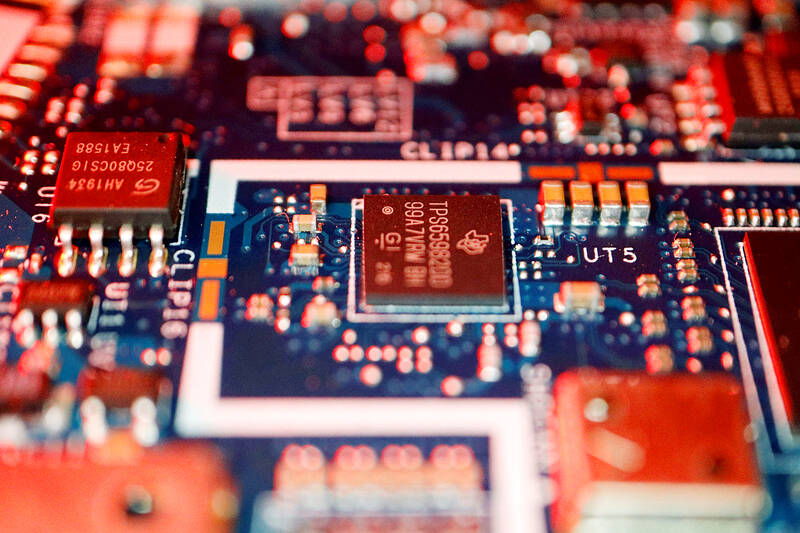The US’ imposition of controls on chip exports to China might throttle Beijing’s plan to obtain breakthrough technologies in chip manufacturing, a study by the Taiwan Industry Economic Services said.
US President Joe Biden in August signed the Creating Helpful Incentives to Produce Semiconductors (CHIPS) and Science Act, which authorizes US$52.7 billion of subsidies for US chipmakers while banning the export of chips more advanced than 28 nanometers to China for 10 years.
It also imposes export controls on technologies linked to diamond and gallium oxide semiconductors, as well as software used in the design of complex circuits and gas turbines.

Photo: REUTERS
South Korea’s Samsung Electronics Co has been hit the hardest by the restrictions, as it has been trying to secure a foothold in the US while having a significant presence in China, the research institute wrote in a study commissioned by the Mainland Affairs Council.
Samsung Electronics has since 2012 invested US$25.8 billion in China, including on manufacturing facilities in Xian which account for 42.5 percent of its NAND flash memorychip manufacturing capacity, the institute said.
Should the US ban prevent Samsung from upgrading its Xian factory, the company’s competitiveness in the memorychip market would suffer a significant setback, it said.
This development would spell trouble for China’s plans to build semiconductor supply chains and limit the potential capacity of the country’s tech industry, it added.
Washington’s efforts to target the Chinese high-tech sector have intensified with the CHIPS Act, which suggests that the trade dispute between the two countries is not likely to abate son, the institute said.
The US-led blockade and regime of surveillance on technologies would profoundly impact the chipmaking sector in China, due to the industry’s dependency on imported products and technologies, it said.
Last year, China’s semiconductor imports surged 23.6 percent to a record US$432.6 billion, indicating that a local chip shortage had reached crisis proportions, the institute said, adding that the problem appears to be worsening.
Despite recent advances in the 7 nanometer process and NAND flash memory manufacturing, China would likely struggle in dealing with the ban due to the US’ control over lithography machines, electronic design automation and crucial chip technologies, it said.
This means continuing US action could snuff out China’s efforts to acquire advanced manufacturing processes and memory chips, it said.
China has also been grappling with a worsening shortage of electronics engineers. In 2020, 210,000 people graduated from electronics engineering departments or related fields, accounting for 2.3 percent of all college graduates, the study said.
Only 13.77 percent, or about 28,000 people, of electronics graduates found work as electronics engineers, it said.
This means China has 250,000 fewer electronic engineers than it needs, further limiting the country’s means of building a national semiconductor industry, it said.
Protectionist regulations being adopted in the US and other countries increasingly prevent China from leveraging foreign acquisitions as a shortcut to foster a domestic technology sector, the study said.
Due to US pressure, companies in the EU, Japan, Singapore and South Korea are discouraged from engaging in technical cooperation with China or outsourcing to that country, a factor that further disadvantages the development of the Chinese semiconductor industry, it said.

The disruption of 941 flights in and out of Taiwan due to China’s large-scale military exercises was no accident, but rather the result of a “quasi-blockade” used to simulate creating the air and sea routes needed for an amphibious landing, a military expert said. The disruptions occurred on Tuesday and lasted about 10 hours as China conducted live-fire drills in the Taiwan Strait. The Civil Aviation Administration (CAA) said the exercises affected 857 international flights and 84 domestic flights, affecting more than 100,000 travelers. Su Tzu-yun (蘇紫雲), a research fellow at the government-sponsored Institute for National Defense and Security Research, said the air

Taiwan is to commence mass production of the Tien Kung (天弓, “Sky Bow”) III, IV and V missiles by the second quarter of this year if the legislature approves the government’s NT$1.25 trillion (US$39.78 billion) special defense budget, an official said yesterday. Commenting on condition of anonymity, a defense official with knowledge of the matter said that the advanced systems are expected to provide crucial capabilities against ballistic and cruise missiles for the proposed “T-Dome,” an advanced, multi-layered air defense network. The Tien Kung III is an air defense missile with a maximum interception altitude of 35km. The Tien Kung IV and V

Trips for more than 100,000 international and domestic air travelers could be disrupted as China launches a military exercise around Taiwan today, Taiwan’s Civil Aviation Administration (CAA) said yesterday. The exercise could affect nearly 900 flights scheduled to enter the Taipei Flight Information Region (FIR) during the exercise window, it added. A notice issued by the Chinese Civil Aviation Administration showed there would be seven temporary zones around the Taiwan Strait which would be used for live-fire exercises, lasting from 8am to 6pm today. All aircraft are prohibited from entering during exercise, it says. Taipei FIR has 14 international air routes and

Taiwan lacks effective and cost-efficient armaments to intercept rockets, making the planned “T-Dome” interception system necessary, two experts said on Tuesday. The concerns were raised after China’s military fired two waves of rockets during live-fire drills around Taiwan on Tuesday, part of two-day exercises code-named “Justice Mission 2025.” The first wave involved 17 rockets launched at 9am from Pingtan in China’s Fujian Province, according to Lieutenant General Hsieh Jih-sheng (謝日升) of the Office of the Deputy Chief of the General Staff for Intelligence at the Ministry of National Defense. Those rockets landed 70 nautical miles (129.6km) northeast of Keelung without flying over Taiwan,